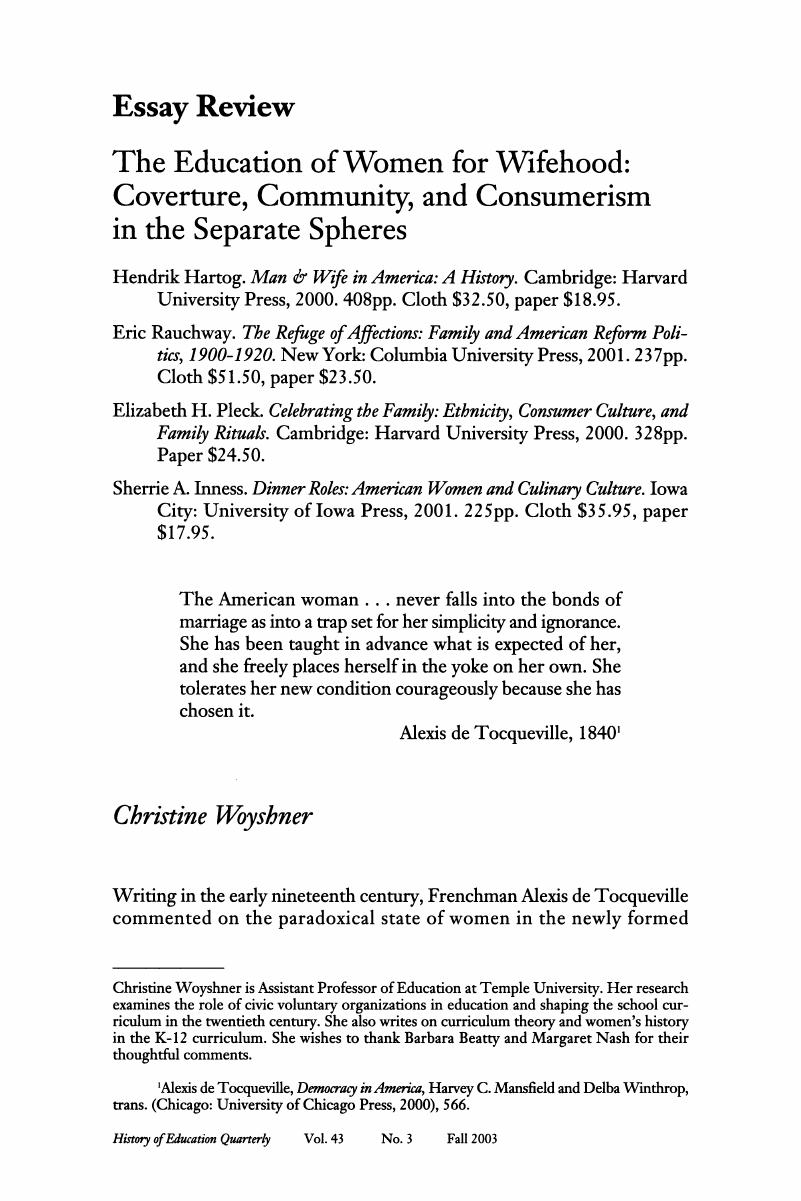Published online by Cambridge University Press: 24 February 2017

1 Alexis de Tocqueville, Democracy in America, Harvey C. Mansfield and Delba Winthrop, trans. (Chicago: University of Chicago Press, 2000), 566.Google Scholar
2 Schwager, Sally “Educating Women in America,“ Signs 12 (1987), 337.Google Scholar
3 Ibid., 336. Schwager's article stands as the most thorough synthesis of women's educational history to date, and merits updating and the addition of recent scholarship.Google Scholar
4 Nash, Margaret A. “Rethinking Republican Motherhood: Benjamin Rush and the Young Ladies’ Academy of Philadelphia,“ Journal of the Early Republic 17 (Summer 1997), 173. Of course Nash mentions the occasional exception to this rule, such as Thomas Woody, A History of Women's Education in the United States, 2 vols. (New York: Science Press, 1922).Google Scholar
5 Nash, Margaret A. “'Cultivating the Powers of Human Beings': Gendered Perspectives on Curricula and Pedagogy in Academies of the New Republic,“ History of Education Quarterly 41 (2001), 242–243.Google Scholar
6 Eisenmann, Linda “Creating a Framework for Interpreting U.S. Women's Educational History: Lessons from the Historical Lexicography,“ History of Education 30 (2001), 453–454.Google Scholar
7 Woyshner, Christine A. and Hao Kuo Tai, Bonnie “Symposium: The History of Women in Education,“ Harvard Educational Review 64: 4 (1997), v.Google Scholar
8 Donato, Rubén and Lazerson, Marvin “New Directions in American Educational History: Problems and Prospects,“ Educational Researcher 29: 8 (November 2000), 12.Google Scholar
9 Lerner, Gerda The Majority Finds Its Past (New York: Oxford University Press, 1981), 145, 146, 158.Google Scholar
10 Ibid., 158.Google Scholar
11 Ibid., 162.Google Scholar
12 Kerber, Linda K. “Separate Spheres, Female Worlds, and Woman's Place: The Rhetoric of Women's History,“ reprinted in History of Women in the United States (New York: K.G. Saur, 1992), 174.Google Scholar
13 Ibid., “Woman's Place: The Rhetoric of Women's History,” 181.Google Scholar
14 Gere, Anne Ruggles Intimate Practices: Literacy and Cultural Work in U.S. Women's Clubs, 1880–1920 (Urbana: University of Illinois Press, 1997), 13.Google Scholar
15 Shaw, Stephanie J. What a Woman Ought to Be and to Do: Black Professional Women Workers during the Jim Crow Era (Chicago: University of Chicago Press, 1996).Google Scholar
16 See for example, Scott, Anne Firor “What, Then, Is the American: This New Woman?“ Journal of American History 65: 3 (1978): 679–703; Sklar, Kathryn Kish Catharine Beecher: A Study in American Domesticity (New Haven: Yale University Press, 1973); and Geraldine Jonçich Clifford, “History as Experience: The Uses of Personal-History Documents in the History of Education,” History of Education 7:3 (1978): 183–96.Google Scholar
17 Blackstone, William “On the Principle of the Unity of Husband and Wife,“ reprinted in Women in American Law, Marlene Stein Wortman, ed. (New York: Holmes and Meier, 1985), 27.Google Scholar
18 See Cott, Nancy F. Public Vows: A History of Marriage and the Nation (Cambridge: Harvard University Press, 2000).Google Scholar
19 Lasch, Christopher Haven in a Heartless World: The Family Besieged (New York: Basic Books, 1977). Sociologist Richard Sennett anticipated some of Lasch's argument: see his Families Against the City: Middle-Class Homes of Industrial Chicago, 1872–1890 (New York: Vintage Books, 1974).Google Scholar
20 For more on women's culture, see Smith-Rosenberg, Carroll “The Female World of Love and Ritual: Relations between Women in Nineteenth Century America,“ Signs 1 (Autumn 1975): 1–29.Google Scholar
21 The standard sources on maternalism include Seth Koven and Sonya Michel, eds., Mothers of a New World: Maternalist Politics and the Origins of Welfare States (New York: Routledge, 1993); Molly Ladd-Taylor, Mother-Work: Women, Child Welfare, and the State, 1890–1930 (Urbana: University of Illinois Press, 1994); and Theda Skocpol, Protecting Soldiers and Mothers: The Political Origins of Social Policy in the United States (Cambridge, MA: Harvard University Press, 1992). Also, see the discussion on the topic in Journal of Women's History 5:2 (Fall 1993).Google Scholar
22 Mitchell, Lucy Sprague Two Lives: The Story of Wesley Claire Mitchell and Myself (New York: Simon & Schuster, 1953). Joyce Antler's biography—relied upon by Rauchway—also delves into the spousal and familial relationship of the Mitchells with much nuance and expertise. Joyce Antler, Lucy Sprague Mitchell: The Making of a Modern Woman (New Haven: Yale University Press, 1987).Google Scholar
23 Similar arguments have been made in the history of education scholarship because similar issues exist. That is, prescriptive curriculum literature is far more readily available to the historian than are students’ and teachers’ reactions to the prescriptions. Nonetheless, historians of education have made a case for the importance of examining the recommendations. For example, Herbert M. Kliebard discusses the symbolic value of curriculum by arguing that “a proclaimed curriculum is a potent way to validate certain forms of knowledge and belief and, whether or not it is implemented in any substantial way, it can be extraordinary revealing about the values a given society or some segment thereof cherishes.” Kliebard, Forging the American Curriculum: Essays in Curriculum History and Theory (New York: Routledge, 1992), xiv. Also, in her discussion of vocational education programs for young women, Jane Bernard Powers writes that prescriptions are myths that “reflect an idealized state of being and that set standards for attitude and behavior.” Powers, The “Girl Question” in Education: Vocational Education for Young Women in the Progressive Era (London: The Falmer Press, 1992), 9.Google Scholar
24 Montalto, Nicholas V. A History of the Intercultural Educational Movement, 1924–1941 (New York: Garland Publishing, 1982). Much more research remains to be undertaken on the variations and interpretations of the intercultural education movement. See recent works by Yoon Pak, “Teaching for Intercultural Understanding in the Social Studies: A Teacher's Perspective in the 1940s” in Christine Woyshner, Joseph Watras, and Margaret Smith Crocco, eds., Social Education in the Twentieth Century: Curriculum and Context for Citizenship (New York: Peter Lang Press, forthcoming).Google Scholar
25 Lerner, The Majority Finds Its Past, 149.Google Scholar
26 Donato and Lazerson, “New Directions in American Educational History,” 12.Google Scholar
27 Beard, Mary Ritter “The Nineteenth Century Woman Looking Forward,“ Young Oxford 2, no. 16 (1901): 119–22, as cited in Rauchway.Google Scholar